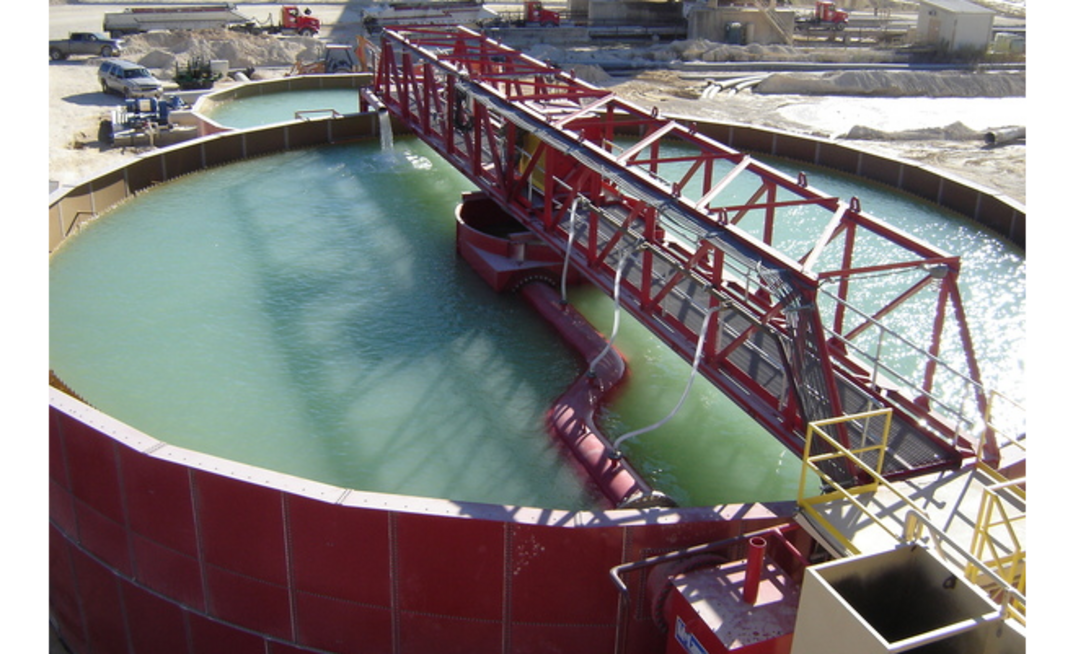Tailings are unavoidable in the mining industry, but that does not mean they have to be a hassle. Thickeners and Filter Presses offer producers the ability to manage their Tailings Storage Facility (TSF) size and environmental impact easier with the potential to create a saleable product, as well as generate clean, recyclable process water.
The best way to deal with tailings is to answer the question "What do you envision as the long-term solution?" This will often depend on the characteristics of the tailings.
If the tailings are comprised of relatively coarse particles (+38 microns), then the answer may be as simple as pumping them to cyclones for recovery and dam building with the fine cyclone overflow being impounded behind the dam.
This method has, for many decades, been employed to both collect/store tailings as well as clarify water for reuse in the process plant. What could possibly be cheaper than to dig a hole or build a dam and create a space for the waste generated by our activities?
There are certainly capital and operational costs associated with this plan. Additionally, there is the potential to be covering up reserves that you may need to get to one day and the loss of process water due to evaporation or percolation.
Besides the costs associated with the pond solution, there are also risks. Social risks include placing the TAF near existing communities and building ever higher impoundment structures as the mine operations progress. Social and environmental impacts from impoundment failure are real and should weigh heavily into any risk analysis. It is our industry's obligation to reduce these risks as much as possible.
Thickeners
If the tailings are finer (-38 microns) and if dams or ponds are still the desired method for storage, it may be worthwhile considering a thickener to prepare the tailings before sending the entire stream out to the TSF. The thickener has the benefit of reducing the total volume headed to the TSF as well as returning most of the process water to the plant immediately. In processing operations today, there are three basic styles of thickeners:
- High rate
- High density
- Paste

McLanahan Thickener
Each of these thickeners share a similar operation as far as feeding and collection of the settled solids. Again, the selection of a thickener to fit your needs depends heavily on what the plans are downstream for the resulting mud. As we progress from high rate to the paste thickener, the underflow solids concentration will increase. Here is where the concept of yield stress comes in to play. In rheology, the yield stress is the minimum amount of shear stress required to initiate and sustain flow. The higher the underflow solids concentration, then the higher the yield stress.
Mine planners can best determine the thickening process by starting at the end of the system and working backward. Answers to the questions regarding how the tails are to be stored, placed, transported, and produced are key to homing in on the thickener design.
If we progress on in the thickening continuum, where do we go after paste thickeners? We now pass into an area where forces other than gravity alone must be introduced to create higher solids concentrations, recessed plate presses. Of particular interest with this technology is the ability to prepare tailings, without additional chemicals, that allow dry stacking and total elimination of impoundments to restrict flow of muds and water.
Yield Stress Continuum
Filter Presses
At its most basic level, the filtration process of a filter press consists of covering two plates with filter media, applying enough force to create a seal between the two filter plates, and then using a feed pump to supply the pressure necessary to pump the slurry into the cavities formed between the two sealed plates. The filter cloth prevents solids from escaping from the plates while allowing the filtrate to pass through the openings in the filter media. Once the chamber is packed full of solids, the feed pump stops, the pressure sealing the plates is released and the filter plates are pulled apart from each other, allowing the dewatered cakes to discharge via gravity.
McLanahan Filter Press
The simplicity and limited movement of filter presses is what lends them to high levels of automation and reliability. The ability to select cycle times, cake thickness, feed pressures and plate styles are what allow filter presses to achieve much drier discharges than many other competing technologies.
Once again, testing your material is always a good place to start when looking at a recessed plate press. Most manufacturers will have facilities for in-house testing to determine filtration times and moistures as a function of feed solids concentration and cake width.
Filter presses are frequently categorized into two main styles: overhead beam and side beam. Each have their own advantages and disadvantages.
Overhead Beam
- The filter plates hang from overhead beams.
- No parts on the sides of the press, providing unobstructed access to change filter cloths on the press without plate removal.
- Much wider plate openings often exceeding 0 .9m between the plates. This creates more movement to aid cake release while also allowing easier access for cloth washing and inspection.
- Dynamic loads are typically isolated from the beams of the press using tension shafts in various configurations.
Side Beam
- The filter plates are supported by beams running along the side of the press.
- Easier to implement shaking systems for applications requiring shaking systems.
- Lower upfront cost
- Less access to plates for cloth washing and inspection. Automatic wash systems should be considered more heavily with side beam style presses due to limited plate access.
To discover more about McLanahan's tailings management solutions please visit mclanahan.com.au
ABOUT THIS COMPANY
McLanahan Corporation
Feeding, Crushing, Sampling, Dewatering and Scrubbing equipment.
HEAD OFFICE:
- 27 Kalinya Close, Cameron Park, NSW 2285, Australia
- Phone: +61 2 4924 8248
- Website: www.mclanahan.com.au
- Email: sales@mclanahan.com.au

























